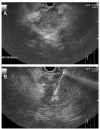Osteoclast: like giant cell undiferrentiated pancreatic tumor diagnosed by means of EUS guided FNA
- PMID: 33988172
- PMCID: PMC8182582
- DOI: 10.23750/abm.v92i2.9482
Osteoclast: like giant cell undiferrentiated pancreatic tumor diagnosed by means of EUS guided FNA
Abstract
Objective: Osteoclast-like giant cell tumours are rare abdominal malignant neoplasms mainly arising in the pancreas. Because of their rarity, clinical and cytopathology reports are very limited, and sonographic features have not been clearly specified ; these tumors are easily misdiagnosed by ultrasound as mucinous cystic tumors (MCTs) or solid pseudopapillary neoplasms (SPNs).
Case study: We report a case of osteoclast like giant cell tumor arising in the pancreas of an 80 year old female patient offered by EUS-FNA cytology on direct and cell block slides. A biphasic pattern composed by a malignant mononuclear cell component and a giant cell component were hallmarks to the diagnosis.
Conclusion: Our case highlights the performance of EUS-FNA in the diagnostic approach of abdominal tumours and the significance of cell block method in the interpretation of osteoclast-like giant cell pancreatic tumour.
Figures




Similar articles
-
Osteoclastic and pleomorphic giant cell tumors of the pancreas diagnosed via EUS-guided FNA: unique clinical, endoscopic, and pathologic findings in a series of 5 patients.Gastrointest Endosc. 2009 Jan;69(1):162-6. doi: 10.1016/j.gie.2008.08.025. Gastrointest Endosc. 2009. PMID: 19111699
-
Endoscopic ultrasound-guided fine-needle aspiration of undifferentiated carcinoma with osteoclast-like giant cells of the pancreas: a report of 2 cases with literature review.Diagn Cytopathol. 2007 Sep;35(9):601-6. doi: 10.1002/dc.20711. Diagn Cytopathol. 2007. PMID: 17703445
-
An indeterminate mucin-producing cystic neoplasm containing an undifferentiated carcinoma with osteoclast-like giant cells: a case report of a rare association of pancreatic tumors.BMC Gastroenterol. 2015 Nov 18;15:161. doi: 10.1186/s12876-015-0391-2. BMC Gastroenterol. 2015. PMID: 26581412 Free PMC article.
-
Osteoclast-like giant cell tumor of the pancreas.Int J Clin Oncol. 2002 Dec;7(6):376-80. doi: 10.1007/s101470200059. Int J Clin Oncol. 2002. PMID: 12494256 Review.
-
Undifferentiated carcinoma with osteoclast-like giant cells of pancreas on cytology: A case report with review of literature.Diagn Cytopathol. 2022 Oct;50(10):E289-E294. doi: 10.1002/dc.25001. Epub 2022 Jun 9. Diagn Cytopathol. 2022. PMID: 35678119 Review.
References
-
- Buickoa JL, Lopez AM, Lopez-Viego MA. Surgical resection of a rare undifferentiated pancreatic carcinoma with osteoclast-like giant cells: a case review. J Med Cases. 2013;4(3):156–158.
-
- Maksymov V, Khalifa MA, Bussey A, Carter B, Hogan M. Undifferentiated (anaplastic) carcinoma of the pancreas with osteoclast-like giant cells showing various degree of pancreas duct involvement. A case report and literature review. JOP. 2011;12(2):170–176. - PubMed
-
- Rosai J. Carcinoma of pancreas simulating giant cell tumor of bone: electron-microscopic evidence of its acinar cell origin. Cancer. 1968;22(2):333–344. - PubMed
-
- Kloppel G, Hruban RH, Longnecker DS. Ductal adenocarcinoma of pancreas. In: Hamilton SR, Aaltonen LA, editors. WHO classification of tumors. Pathology and Genetics of tumors of the digestive system. Lyon: IARC Press; 2000.
Publication types
MeSH terms
LinkOut - more resources
Full Text Sources
Medical

